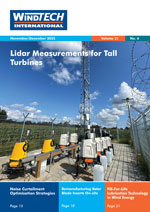- Category: Articles
Preliminary Results from New Modelling Study
Optimising the layout of an offshore wind farm is an iterative process, and adds expense to wind farm development. The Offshore Wind Farm Layout Optimization (OWFLO) project seeks to streamline this process by uniting efficient optimisation algorithms with models of offshore farm costs and energy production. Most software configures farms for maximum energy production, but this does not account for the significant, site-specific costs of components such as the support structure and electrical interconnection. The OWFLO software instead models the levelised production cost to identify the combination of maximum energy production and minimum cost of energy that best suits the site. This article summarises the initial scope and progress of this project and presents a comparison with data from an actual offshore wind farm. The overall energy and cost of energy estimations compare well with the real data, and methods for further improvement of the models are described.
By Christopher Elkinton, James Manwell and Jon McGowan, University of Massachusetts, USA
- Category: Articles
The Impact on Navigation of an Offshore Wind Farm
 Economic and social use of the sea has been fundamental in human history. Offshore wind farms are the most recent development and are a major change to the marine environment. They need to safely share the sea with many other users.
Economic and social use of the sea has been fundamental in human history. Offshore wind farms are the most recent development and are a major change to the marine environment. They need to safely share the sea with many other users.By Michael Starling, BMT Renewables Limited (a subsidiary of BMT Limited), UK
- Category: Articles
Storage for Large-Scale Wind Power
 The world’s wind resources are huge. But as wind becomes a larger fraction of electricity generation, grid integration must be resolved, particularly to smooth fluctuations in wind power output. Adding energy storage or back-up has been proposed as a solution, but dedicated storage or back-up adds capital cost to wind power. This article proposes vehicle-to-grid power (V2G) as a storage resource for large-scale wind power.
The world’s wind resources are huge. But as wind becomes a larger fraction of electricity generation, grid integration must be resolved, particularly to smooth fluctuations in wind power output. Adding energy storage or back-up has been proposed as a solution, but dedicated storage or back-up adds capital cost to wind power. This article proposes vehicle-to-grid power (V2G) as a storage resource for large-scale wind power. By Willett Kempton and Amardeep Dhanju, University of Delaware, USA
- Category: Articles
Soil Investigations for Offshore Wind Turbine Projects
 On several occasions, the soil conditions have proved to be a key area for offshore wind farm projects; often this can result in disputes between the various parties involved over responsibilities. Despite the soil investigation being the owner’s responsibility, this responsibility is often delegated to a subcontractor. The importance of a thorough and well-performed soil investigation cannot be understated for the design of offshore support structures. A good and well-documented design basis that includes adequate geotechnical information will facilitate ‘fast-track’ project development and a project of high quality with only minor variation orders to the contract; on the other hand, a poorly carried out soil investigation can open up the project to delays and major variation orders, or a conservative and costly design.
On several occasions, the soil conditions have proved to be a key area for offshore wind farm projects; often this can result in disputes between the various parties involved over responsibilities. Despite the soil investigation being the owner’s responsibility, this responsibility is often delegated to a subcontractor. The importance of a thorough and well-performed soil investigation cannot be understated for the design of offshore support structures. A good and well-documented design basis that includes adequate geotechnical information will facilitate ‘fast-track’ project development and a project of high quality with only minor variation orders to the contract; on the other hand, a poorly carried out soil investigation can open up the project to delays and major variation orders, or a conservative and costly design. By Tove Feld, DNV Global Wind Energy, Denmark
- Category: Articles
A Program for Wind Turbine Design
 Motivated by the growing installation of wind energy systems all over the world and with the perspective of wind energy utilisation in Brazil, the authors present a simplified model to evaluate the optimum aerodynamic configuration for the rotor blades of a horizontal axis wind turbine (HAWT). The model is based on the conservation equations and the Panel Method, and a limited set of geometric parameters that strongly affect the rotor aerodynamics are calculated.
Motivated by the growing installation of wind energy systems all over the world and with the perspective of wind energy utilisation in Brazil, the authors present a simplified model to evaluate the optimum aerodynamic configuration for the rotor blades of a horizontal axis wind turbine (HAWT). The model is based on the conservation equations and the Panel Method, and a limited set of geometric parameters that strongly affect the rotor aerodynamics are calculated. By Daniel Fonseca de Carvalho e Silva, Luiz Henrique Gomes Pereira and Gustavo C.R. Bodstein, Brazil
- Category: Articles
The New Aeroelastic Code HAWC2
The article describes work to investigate the effects on tower dynamics when mounting a turbine on a monopile foundation offshore compared to a similar onshore installation. Changes in frequency, mode shapes and damping were investigated, including effects of hydrodynamics and non-linear soil properties. The tool used for the investigation is the new aeroelastic code HAWC2, which is based on a multibody formulation. This formulation is very general, which means that it can handle any structural object (body) as well as large rotations between the bodies and their associated non-linear effects. Thus, for example, complex foundation types such as very flexible monopile foundations, tripod structures and even floating support structures can be simulated in the code.
By Torben J. Larsen, Helge A. Madsen and Kenneth Thomsen, Risø, National Laboratory Denmark
.
- Category: Articles
The Beamforming Technique in Acoustic Imaging
 Thanks to the evolution of both computer and electronic science it is now possible (and easy) to use the acoustic imagery technique to investigate the noise behaviour of a wind turbine under operation. This article introduces the beamforming technique used in acoustic imagery for noise problem troubleshooting. It describes the parameters that are used to produce accurate acoustic images to locate the noise source of interest. Non-stationary noise sources, fast transient events and also mobile noise sources are all easily located with the technique.
Thanks to the evolution of both computer and electronic science it is now possible (and easy) to use the acoustic imagery technique to investigate the noise behaviour of a wind turbine under operation. This article introduces the beamforming technique used in acoustic imagery for noise problem troubleshooting. It describes the parameters that are used to produce accurate acoustic images to locate the noise source of interest. Non-stationary noise sources, fast transient events and also mobile noise sources are all easily located with the technique.By Vincent Benoit, ACB Engineering, France










